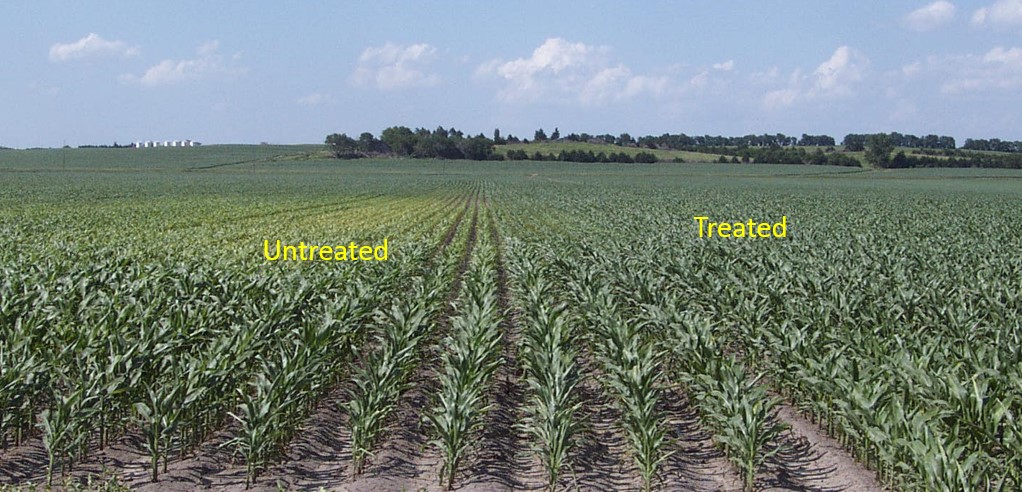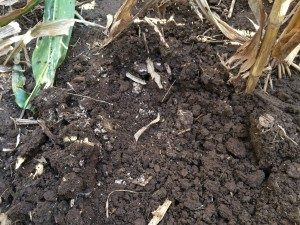PRO CAL 40 gypsum-Even More Than You Bargained For
We promote PRO CAL 40, our brand of gypsum, as a soil amendment to condition the soil, but it is even more than that. Numerous researchers have shown that gypsum does improve soil’s ability to absorb water and decrease runoff. It also improves soil structure by supplying calcium for flocculation of the clay particles.
However, another benefit of gypsum is that it provides a very cost effective source of sulfur and calcium. Current market price for sulfur is around fifty cents per pound of sulfur. At the current price the cost for sulfur in PRO CAL 40 is about five cents per pound of sulfur, making it a real bargain, and you get the calcium thrown in at no cost.

Why Gypsum Works in Your Soil: Part 1 Reduces Surface Sealing
There are many reasons why we see responses from gypsum in agricultural soils. This blog is the first of six discussing the benefits of gypsum.
Gypsum gives responses in most soils by supplying a good source of electrolytes which rain water can react with. Without electrolytes present, rain water will cause greater soil dispersion and surface sealing. The benefit of having gypsum soluble, but not too soluble, is that it will not leach quickly through the soil profile and will stay near the soil surface where it can reduce surface sealing.
With heavy rains in many areas this year surface sealing could be a greater concern since the electrolytes in the soil will be depleted. Gypsum applications will alleviate these soil problems.
The solubility of gypsum is about 2.05 g/L in water (77 degrees Fahrenheit). This is about 200 times the solubility of most liming materials. Fineness of grind or particle size will also greatly affect dissolution rates and solubility of both lime and gypsum. In soil, it has been determined that gypsum passing a 100 mesh screen will solubilize at a rate of about 35# per one inch of rainfall.
 In the picture you can see the white gypsum that is still visible in the soil from the previous year’s application. Also notice the granular soil structure. Earthworms were easily observed in this soil and their “huts” of leaves and crop residue were prevalent. Typically, we have observed that a ton of PRO CAL 40 applied per acre will last about three years given the rainfall we receive during the growing season. This gypsum near the surface continuing to solubilize reduces surface crusting over those three to four years. When you spread the cost of a gypsum application over four years, the cost per acre is less than $10 in most of our marketing area. That is very economical considering that many customers have shown 10 bushel or more responses in corn and five plus bushels in soybeans all while improving their soil both short term and long term. “My soil just keeps improving each year after an application of PRO CAL 40”, said one of our customers recently.
In the picture you can see the white gypsum that is still visible in the soil from the previous year’s application. Also notice the granular soil structure. Earthworms were easily observed in this soil and their “huts” of leaves and crop residue were prevalent. Typically, we have observed that a ton of PRO CAL 40 applied per acre will last about three years given the rainfall we receive during the growing season. This gypsum near the surface continuing to solubilize reduces surface crusting over those three to four years. When you spread the cost of a gypsum application over four years, the cost per acre is less than $10 in most of our marketing area. That is very economical considering that many customers have shown 10 bushel or more responses in corn and five plus bushels in soybeans all while improving their soil both short term and long term. “My soil just keeps improving each year after an application of PRO CAL 40”, said one of our customers recently.
Why Gypsum Works in Your Soil: Part 2 Good Source of Calcium in all Soils
Gypsum contains about 22% calcium and since soil pH has little effect on its solubility, it is a good source of calcium in high pH soils. Calcium in high pH soils often is fixed as calcium carbonate. Managing alkaline soil pH is best done by maintaining high levels of free calcium in the soil. This is why gypsum is added to soils with high soil pH (>8.0). Gypsum is an excellent and inexpensive source of soluble calcium.
Calcium is often overlooked as a crop nutrient. Most soil fertility specialists assume that so long as your soil pH is sufficient that you will have adequate calcium nutrition. This is only partly correct.
We should first consider the importance that calcium plays in the plant. Calcium is sometimes called “the trucker of all nutrients”. This is because calcium improves the absorption of all nutrients and helps in their translocation within the plant. Calcium helps neutralize organic acids in plants that form during cell metabolism, therefore helping maintain proper pH. Calcium activates several enzyme systems that serve as plant growth regulators. Calcium helps convert nitrate-nitrogen into ammonium forms of nitrogen needed for protein formation. Calcium is critical for normal cell division and for strong cell walls. Also very important is that calcium improves disease resistance in plants. Lastly calcium improves water use efficiency by plants.
Calcium Improves Water Efficiency
Nutrients can play a key role in improving plant water efficiency. Calcium is most important for water efficiency because:
- Calcium and calmodulin (calcium modulated protein) act as a messenger molecule to jump start plant protection devices.
- Calcium helps stabilize plasma membranes and decreases hydrogen peroxide concentrations which increase with drought stress. This maximizes cell water content.
- Calcium is vitally important for root hair growth increasing root surface area significantly increasing water uptake.
- Calcium works with abscisic acid (formed especially when under drought stress) to increase water conductivity within the plant.
- Calcium is involved with the closing and opening of the stomata decreasing transpiration losses.
- Calcium improves cell wall thickness and reduces cuticle breaks where water can be lost from the leaf.
In the soil, calcium works with microbial populations to improve decomposition of organic matter and crop residue to convert to plant available nutrients. It also enhances nitrogen-fixing bacteria in the soil so that more nodules are formed on legume roots increasing the amount of nitrogen produced. Obviously, calcium plays a key role in plants and soil.
Factors that can affect calcium availability from the soil is the balance with other nutrients. If calcium is low because you have an imbalance with magnesium, potassium, sodium, aluminum or hydrogen, your plants may be stressed. If pH is low, you may encounter an imbalance with hydrogen and aluminum (particularly pH< 5.3). If your soils have been heavily manured or received high amounts of lagoon water you may have an imbalance with potassium and possibly magnesium. In some soils you may have high magnesium levels due to the soil’s parent material (or soil erosion) that can cause an imbalance with calcium. These soils will be stickier and less friable decreasing root development and nutrient uptake. They also have slower water infiltration, which will also reduce water efficiency.
Another factor that can affect calcium availability is high levels of carbonates and bicarbonates in the soil. This will be related to high sodium levels and/or high pH levels in the soil. Irrigation water can also contain high levels of carbonates and bicarbonates. Carbonates and bicarbonates will react with calcium making this calcium less available for plant uptake. This calcium will probably appear on the soil test as exchangeable calcium, but in reality is not plant available. This is why some high pH soils may actually be low in calcium availability. Acid reactions in the soil that acidify this calcium carbonate will make the calcium available.
Most common sources of calcium for agricultural crops include calcium carbonate (limestone) and calcium sulfate (gypsum). Both are good sources of calcium as long as they have small particle size and applied in the correct soil conditions. Limestone is most effective as a calcium source in low pH soils where it will be reactive. It is not a good calcium source in high pH soils since it won’t be soluble. Gypsum is a soluble form of calcium at all soil pH levels.
